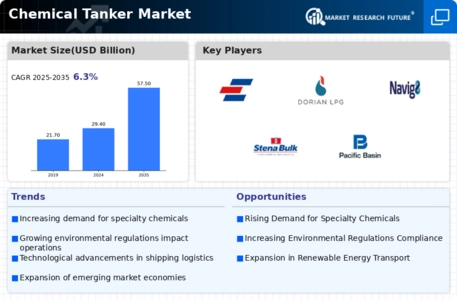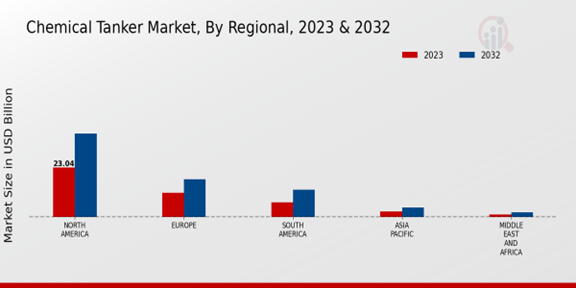Expansion of Global Trade
The expansion of global trade plays a crucial role in the growth of the Global Chemical Tanker Market Industry. As economies become more interconnected, the demand for chemical transportation across borders increases. This trend is particularly evident in emerging markets, where industrialization and urbanization drive the need for chemicals in various applications. The anticipated growth in trade volumes is likely to propel the market, with estimates suggesting a market size of 57.5 USD Billion by 2035. The ability of chemical tankers to navigate diverse shipping routes positions them as vital assets in facilitating international trade.
Market Trends and Projections
The Global Chemical Tanker Market Industry is characterized by dynamic trends and projections that reflect its evolving landscape. As of 2024, the market is valued at 29.4 USD Billion, with expectations to reach 57.5 USD Billion by 2035. The projected CAGR of 6.28% from 2025 to 2035 indicates a robust growth trajectory, driven by factors such as rising demand for specialty chemicals, global trade expansion, and technological advancements. These trends highlight the industry's resilience and adaptability in a rapidly changing economic environment.
Growing Environmental Concerns
Growing environmental concerns are prompting the Global Chemical Tanker Market Industry to adopt more sustainable practices. As regulations tighten and public awareness increases, there is a push for greener shipping solutions. Chemical tanker operators are exploring alternative fuels and eco-friendly technologies to minimize their carbon footprint. This shift not only addresses regulatory pressures but also aligns with the global trend towards sustainability. The industry's response to these concerns is likely to influence market dynamics, as companies that prioritize environmental responsibility may gain a competitive edge in the Global Chemical Tanker Market Industry.
Rising Demand for Specialty Chemicals
The Global Chemical Tanker Market Industry experiences a notable surge in demand for specialty chemicals, driven by various sectors including pharmaceuticals, agrochemicals, and food additives. As industries increasingly require tailored chemical solutions, the need for efficient transportation of these products becomes paramount. This trend is expected to contribute significantly to the market's growth, with projections indicating a market value of 29.4 USD Billion in 2024. The ability of chemical tankers to transport diverse and sensitive cargoes under controlled conditions enhances their appeal, thereby solidifying their role in the Global Chemical Tanker Market Industry.
Technological Advancements in Shipping
Technological advancements are reshaping the Global Chemical Tanker Market Industry, enhancing operational efficiency and safety. Innovations such as automated navigation systems, real-time monitoring, and advanced cargo handling techniques are becoming increasingly prevalent. These technologies not only improve the reliability of chemical transportation but also reduce operational costs. As the industry embraces digital transformation, the potential for increased efficiency and reduced environmental impact becomes apparent. This trend is expected to attract investment and drive growth in the market, aligning with the projected CAGR of 6.28% for the period from 2025 to 2035.
Regulatory Compliance and Safety Standards
The Global Chemical Tanker Market Industry is significantly influenced by stringent regulatory compliance and safety standards. Governments worldwide impose regulations to ensure the safe transportation of hazardous materials, necessitating advanced technologies and practices within the industry. Compliance with these regulations not only enhances safety but also fosters trust among stakeholders. As a result, chemical tanker operators are increasingly investing in modern fleets equipped with state-of-the-art safety features. This trend is likely to drive market growth, as adherence to safety standards becomes a competitive advantage in the Global Chemical Tanker Market Industry.



 Source: Primary Research, Secondary Research, Market Research Future Database and Analyst Review
Source: Primary Research, Secondary Research, Market Research Future Database and Analyst Review 











